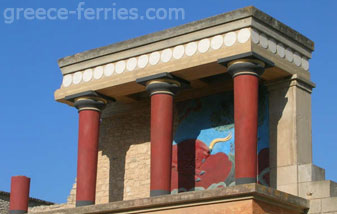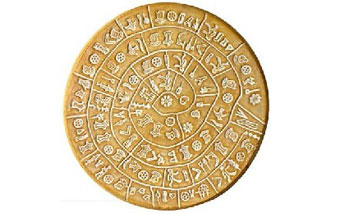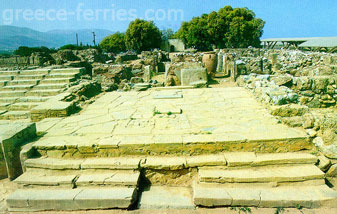HERAKLION TRAVEL GUIDE

Please note
My Reservation
Modal title
Please note
Heraklion Ferries
See what our customers say about us!
Reviews
4.9 stars
1162 reviews

YOUR PERSONAL
FERRY BOOKING AGENT
Each of our customers is assigned a personal Ferry Booking Agent who speaks their language and replies within 3 working hours. Your agent is available to you before, during and after your trip.
Greekferries Club Bonus Per Mile
Collect 'miles' every time you travel by ferry, regardless of the ferry company you travel with!
Redeem your Miles and get discounts and FREE tickets!
Economy Car Rentals
in HeraklionOffers all year round!
Rent a Car
Heraklion Ferries Crete Island
Ships and Ferries to Heraklion in the Crete IslandTravel Information for ferries to Heraklion. Heraklion - Crete Island
HERAKLION > ARCHAEOLOGY
ARCHAEOLOGYKnossos

The Royal Palace of Knossos is the largest of the Minoan period; a building complex covering an area of 22,000 m² situated 5 km south of Heraklion. The palace belonged to the Minoan King, Minos.
The first palace was built about 2000 B.C., but the southern end was destroyed about 1900 B.C. by an earthquake, which was again destroyed by another earthquake about 1700 B.C. The similarity of building styles between the palaces of Malia and Phaestos are in contrast to the first palace of Knossos. Significantly, the corridors at Knossos do not follow a straight line and justify the myth of a labyrinth. A larger palace was built around 15th century B.C. In the throne room was the administrative centre from where the rulers gathered and governed the island. The palace was again destroyed in 14th century B.C., this time by fire when it ceased to be the ruling centre.
The first excavations of Knossos were begun by M Kalokerinou in 1878 and were continued in 1900 by Sir Arthur Evans, an Englishman, who found the basic structure. Excavations continued with Sir Arthur reinforcing the palace until 1931.
Phaestos

The Minoan Palace of Phaestos is the second largest after Knossos covering an area of 18,000 m² and is built on a hill to the western end of the Messara plain. Phaestos was ruled by Radamanos, brother of Minos and is estimated to have been built around 1900 BC, but was destroyed 200 years later by an earthquake. A new, larger palace was built which was destroyed in 1450 BC, possibly by the eruption of the volcano of Santorini.
Excavations of the site began in 1884 by the Italians, Halbherr and Taramelli. After the establishment of the Cretan state in 1898 further excavations were made by Halbherr and Pernier, 1900-1914. Later excavations were undertaken by Doro Levi, 1950-1971 overseen by the Italian Archaeological School of Athens. Some reinforcement has been done with concrete and covered in part with plastic sheeting.
The Royal Villa of the Holy Trinity

The Royal Villa of Agia Triada is located 3 km from Phaestos and 64 km from Heraklion. It was built on a hill around 1600 BC and is a fine example of Minoan architecture. It is believed to have been used as a summer palace by the king of Phaestos. It was destroyed around 1400 BC. The most important of the relics found was a sarcophagus during one of the excavations on the site from 1902 onwards.
Malia

The Minoan Palace at Malia was not as elaborate as Knossos. The site has been occupied from Neolithic times and inhabited from the 3rd millennium up to the prehistoric period. Its location shows that it was important for naval and trading activities. The palace was destroyed about 1450 BC. Excavations began in 1915.
Gortyna

The site of Gortyna was inhabited for the first time towards the end of the Neolithic period, but its development is from after the Minoan period. Relics of the archaic period were found in the area of the acropolis. According to the Laws of 5th century BC, the development of the town continued into the Hellenic period.
During the Roman occupation Gortyna became an ally of Rome and was the capital of Crete. It was totally destroyed by the Saracens in 824 AD.
Amnissos
The habitation of the village of Paleohora, Amnissos, began during the middle Minoan period, about 1900 BC. The name of Amnissos is referred to in the Linear B tablets. The Villa of the Lilies was destroyed by fire in 15th century BC, as were the other places of the Minoan period, probably by the catastrophic explosions of the volcano on Santorini.
The complexes C and E continued to be inhabited up to 12th century BC. During the 7th century BC the Temple of Dios Themata was founded and continued to be used until 2nd century AD. The hill was again occupied during the Venetian period.
Why book with Greekferries Club
Simple. We are here for you every step of the way.

The Greekferries
Booking Engine
Enter your ferry routes and travel dates and we guide you from there. Find all schedules, availability and prices and book your ferry tickets in three simple steps!

The Best Ferry Ticket Price
We include all the discounts you are entitled to. You don’t have to do any research!

The Secure Payments
Our payment gateway is fully compliant with the PSD2 SCA / EMV 3-D Secure 2.0 directives and guidelines.

The Chat Service
If you encounter any difficulty or simply have a question, use the chat service in our booking engine and we’ll be happy to help!

YOUR Personal
Ferry Booking Expert
Whether you complete your booking online or ask for our assistance, you will be paired with an experienced agent who speaks your language fluently.